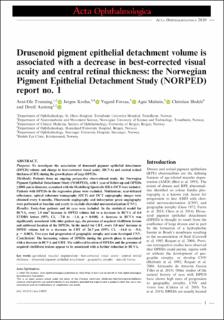| dc.contributor.author | Tvenning, Arnt-Ole | |
| dc.contributor.author | Krohn, Jørgen | |
| dc.contributor.author | Forsaa, Vegard Asgeir | |
| dc.contributor.author | Malmin, Agni | |
| dc.contributor.author | Hedels, Christian | |
| dc.contributor.author | Austeng, Dordi | |
| dc.date.accessioned | 2020-04-17T07:23:15Z | |
| dc.date.available | 2020-04-17T07:23:15Z | |
| dc.date.created | 2020-04-16T13:22:31Z | |
| dc.date.issued | 2020 | |
| dc.identifier.citation | Acta Ophthalmologica. 2020, | en_US |
| dc.identifier.issn | 1755-375X | |
| dc.identifier.uri | https://hdl.handle.net/11250/2651418 | |
| dc.description.abstract | Purpose To investigate the association of drusenoid pigment epithelial detachment (DPED) volume and change in best‐corrected visual acuity (BCVA) and central retinal thickness (CRT) during the growth phase of large DPEDs. Methods Patients from an ongoing prospective observational study, the Norwegian Pigment Epithelial Detachment Study (NORPED), with 1 year of follow‐up and DPEDs ≥1000 µm in diameter, examined with the Heidelberg Spectralis HRA‐OCT were included. Patients with DPEDs in the regression phase were excluded. Multicolour, near‐infrared reflectance, optical coherence tomography (OCT) and OCT angiography images were obtained every 6 months. Fluorescein angiography and indocyanine green angiography were performed at baseline and yearly to exclude choroidal neovascularization (CNV). Results Forty‐four patients and 66 eyes were included. In the statistical model for BCVA, every 1.0 mm3 increase in DPED volume led to a decrease in BCVA of 4.0 ETDRS letters (95% CI, −7.0 to −1.0, p = 0.008). A decrease in BCVA was significantly associated with older patient age, the presence of acquired vitelliform lesions and subfoveal location of the DPEDs. In the model for CRT, every 1.0 mm3 increase in DPED volume led to a decrease in CRT of 26.7 µm (95% CI, −44.4 to −9.0, p = 0.003). Two eyes had progression of geographic atrophy and none developed CNV. Conclusion The increasing volume of DPEDs during the growth phase is associated with a decrease in BCVA and CRT. The subfoveal location of DPEDs and the presence of acquired vitelliform lesions appear to be associated with a further reduction in BCVA. | en_US |
| dc.language.iso | eng | en_US |
| dc.publisher | ohn Wiley & Sons Ltd on behalf of Acta Ophthalmologica Scandinavica Foundation | en_US |
| dc.rights | Navngivelse-Ikkekommersiell 4.0 Internasjonal | * |
| dc.rights.uri | http://creativecommons.org/licenses/by-nc/4.0/deed.no | * |
| dc.title | Drusenoid pigment epithelial detachment volume is associated with a decrease in best‐corrected visual acuity and central retinal thickness: the Norwegian Pigment Epithelial Detachment Study (NORPED) report no. 1 | en_US |
| dc.type | Peer reviewed | en_US |
| dc.type | Journal article | en_US |
| dc.description.version | publishedVersion | en_US |
| dc.source.journal | Acta Ophthalmologica | en_US |
| dc.identifier.doi | 10.1111/aos.14423 | |
| dc.identifier.cristin | 1806619 | |
| dc.description.localcode | This is an open access article under the terms of the Creative Commons Attribution‐NonCommercial‐NoDerivs License, which permits use and distribution in any medium, provided the original work is properly cited, the use is non‐commercial and no modifications or adaptations are made. | en_US |
| cristin.ispublished | true | |
| cristin.fulltext | original | |
| cristin.qualitycode | 2 | |

